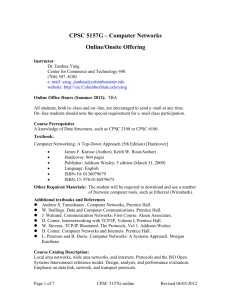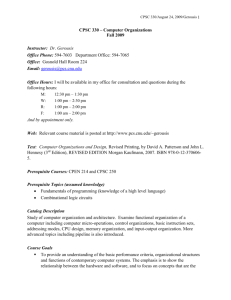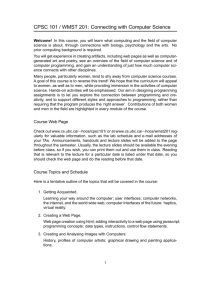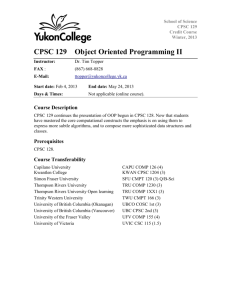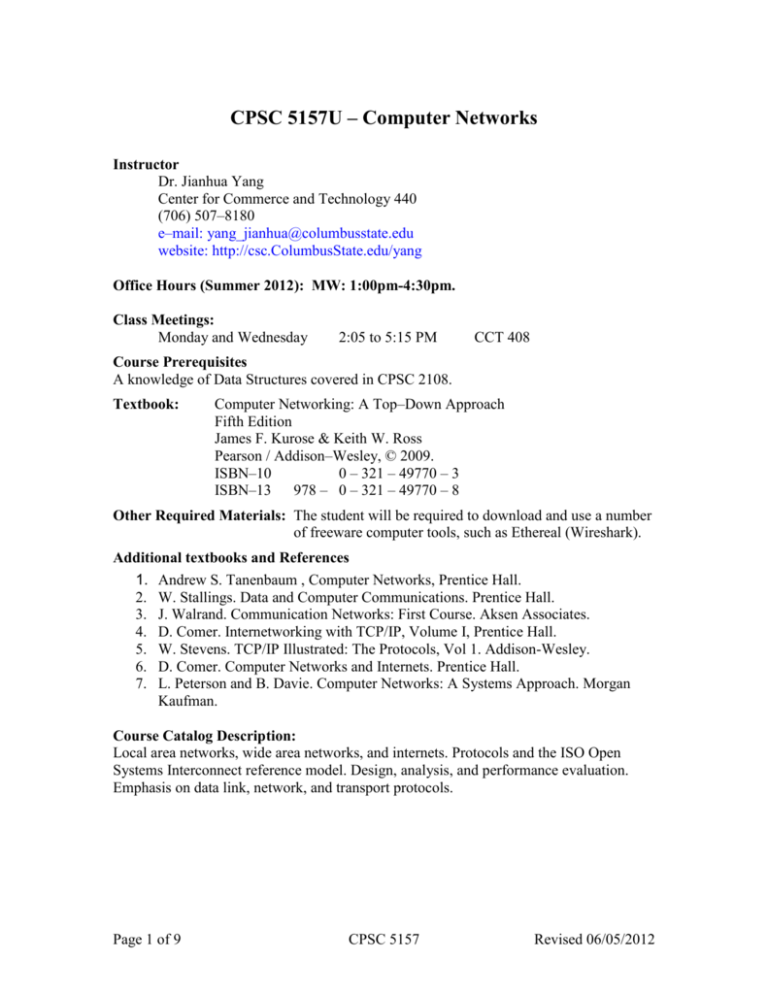
CPSC 5157U – Computer Networks
Instructor
Dr. Jianhua Yang
Center for Commerce and Technology 440
(706) 507–8180
e–mail: yang_jianhua@columbusstate.edu
website: http://csc.ColumbusState.edu/yang
Office Hours (Summer 2012): MW: 1:00pm-4:30pm.
Class Meetings:
Monday and Wednesday
2:05 to 5:15 PM
CCT 408
Course Prerequisites
A knowledge of Data Structures covered in CPSC 2108.
Textbook:
Computer Networking: A Top–Down Approach
Fifth Edition
James F. Kurose & Keith W. Ross
Pearson / Addison–Wesley, © 2009.
ISBN–10
0 – 321 – 49770 – 3
ISBN–13 978 – 0 – 321 – 49770 – 8
Other Required Materials: The student will be required to download and use a number
of freeware computer tools, such as Ethereal (Wireshark).
Additional textbooks and References
1. Andrew S. Tanenbaum , Computer Networks, Prentice Hall.
2. W. Stallings. Data and Computer Communications. Prentice Hall.
3. J. Walrand. Communication Networks: First Course. Aksen Associates.
4. D. Comer. Internetworking with TCP/IP, Volume I, Prentice Hall.
5. W. Stevens. TCP/IP Illustrated: The Protocols, Vol 1. Addison-Wesley.
6. D. Comer. Computer Networks and Internets. Prentice Hall.
7. L. Peterson and B. Davie. Computer Networks: A Systems Approach. Morgan
Kaufman.
Course Catalog Description:
Local area networks, wide area networks, and internets. Protocols and the ISO Open
Systems Interconnect reference model. Design, analysis, and performance evaluation.
Emphasis on data link, network, and transport protocols.
Page 1 of 9
CPSC 5157
Revised 06/05/2012
CPSC 5157U – Computer Networks
Undergraduate Offering
Course Description
This course is a broad introduction to networking concepts and emphasizes the following:
1. Local area networks, wide area networks, and internets.
2. Protocols and the OSI (Open Systems Interconnect) reference model.
3. Design, analysis, and performance evaluation.
Course Topics
1. The large–scale structure of the global Internet and its associated protocols;
2. The OSI Reference Model and the Internet Protocol Stack;
3. The Application Layer: Structure and sample applications;
4. The Transport Layer: Its function and services;
5. Reliable data transport and congestion control;
6. The uses of UDP and TCP; the trade–offs between them;
7. The Network Layer: Its function and services;
8. The structure of IP addresses: classful and classless addresses;
9. The DNS (Domain Name Service): “User friendly” names & IP addresses;
10. Routing on the Internet;
11. The Link Layer: Its function and services;
12. Error detection and correction techniques;
13. Collision detection and the Ethernet solution to that problem;
14. Collision avoidance and the Token Ring solution to that problem;
15. Link–layer switches: forwarding and filtering;
Learning Objectives
1.
2.
3.
4.
Become familiar with layered communication architectures (OSI and TCP/IP).
Understand the client/server model and key application layer protocols.
Learn sockets programming and how to implement client/server programs.
Understand the concepts of reliable data transfer and how TCP implements these
concepts.
5. Know the principles of congestion control and trade-offs in fairness and
efficiency.
6. Learn the principles of routing and the semantics and syntax of IP.
7. Understand the basics of error detection including parity, checksums, and CRC.
8. Know the key protocols for multimedia networking including IntServ and
DiffServ for IP.
9. Familiarize the student with current topics such as security, network management,
sensor networks, and/or other topics.
10. Increase the ability to write a report to a project or a hand-on exercise and make a
presentation.
Learning Outcomes
Upon successful completion of the courses in this discipline, the student will:
Page 2 of 9
CPSC 5157
Revised 06/05/2012
CPSC 5157U – Computer Networks
Undergraduate Offering
1. Demonstrate oral and written communication skills and increase ability to be
effective team members.
Strategies:
o Study of current research topics in computer network
o Use Wireshark hands-on exercise report writing and presentation
o Write team project report and make a presentation
o Summarize research paper in computer network and make a
presentation
ABET Criteria: A, B, C, F, I, and J
CS Program Objectives: 2, 3, and 4
Assessment: Project, hands-exercise report writing, research paper summary,
oral presentation.
2. Demonstrate the basic knowledge of intranet, internet, and the Internet.
Strategies:
o Study chapter 1 of the textbook
o Conduct hands-on exercise to design a and set up a local area network
o Exercise tools to explore intranet and the Internet infrastructure
ABET Criteria: A, B, and C
CS Program Objectives: 2, 3
Assessment: Written assignment, Hands-on lab report, quiz, and network
online tools practicing report
3. Demonstrate the knowledge of computer network programming, such as socket
programming.
Strategies:
o Study chapter 2, and 3 of the textbook
o Conduct hands-on socket programming on TCP and UDP
o Exercise Wireshark hands-on lab
ABET Criteria: A, B, C, I and J
CS Program Objectives: 2, 3
Assessment: Programming assignment, Programming Project, Hands-on labs
4. Demonstrate the understanding of internet model, or OSI model and the TCP/IP
protocol suit.
Strategies:
o Study chapter 2, 3, 4, 5
o Use Wireshark hands-on labs
o Learn network online tools
o Conduct computer network projects
o Read some TCP/IP related research papers
Page 3 of 9
CPSC 5157
Revised 06/05/2012
CPSC 5157U – Computer Networks
Undergraduate Offering
o Read protocol-related RFC files
ABET Criteria: A, B, C, E, I, J, and K
CS Program Objectives: 2, 3
Assessment: Writing assignment, project, exam, hands-on labs
5. Demonstrate the ability to apply computer network knowledge to solving a real
world application.
Strategies:
o Study one of two of chapter 6, 7, 8, 9 of the textbook
o Conduct a comprehensive project
o Conduct a short term internship if possible
o Conduct a field trip to local IT company, campus IT center
ABET Criteria: A, B, C, D, E, F, I, J, and K
CS Program Objectives: 1, 2, 3, 4
Assessment: Project report, presentation, internship report, or field trip report.
Course Methods
1. The class will be a lecture course, taught face to face.
2. Laboratory experiences will be part of the course.
3. Students will be expected to complete hands-on exercises and a series of
programming assignments.
Student Responsibilities
1. Attend class regularly (if so enrolled) and participate in all class discussions.
2. Complete all reading assignments and all homework assignments.
3. Ask the instructor questions.
4. Send the instructor e–mail with both comments and questions.
Instructor Responsibilities
1. Give lectures on the course material.
2. Assign appropriate homework that illustrates the concepts of the course, and
grade and return the homework in a timely manner with adequate explanation.
3. Give tests over the material and grade and return the tests in a timely manner
4. Provide a website that supports the course.
5. Provide at least four hours of office time primarily designated for assistance of
students in this class, at times expected to be convenient for the students. It is
expected that the instructor be available to the students during these hours.
6. Reply promptly (within one business day) to all student e–mail communications.
Methods for Evaluating Students
The evaluation methods will include homework and a comprehensive final exam. In
addition there is a “class participation” component to the grade.
Assignments
Hands-on labs
Programming Project
Page 4 of 9
10%
10%
10%
CPSC 5157
Revised 06/05/2012
CPSC 5157U – Computer Networks
Online Quiz
Online Discussion
Mid-Term Exam
Final Exam
10%
10%
20%
30%
Undergraduate Offering
When scheduled by the University Registrar.
The Exams: All exams will be given in class. They may be either open–book or
closed–book, depending on the context. The time allocated will be the standard.
The Mid–Term Exam will be a one–hour exam.
The Final Exam will be a two–hour exam.
Assignment of Letter Grades
The method of assigning letter grades based on overall course averages is fairly standard.
The basic method for assigning grades is described as follows:
Average
90 – 100
80 – 89
70 – 79
60-69
Below 60
Page 5 of 9
Letter Grade
A
B
C
D
F
CPSC 5157
Revised 06/05/2012
CPSC 5157U – Computer Networks
Undergraduate Offering
Tentative Topic Schedule
Week Date
1
06/12
06/14
2
06/19
06/21
3
06/26
06/28
4
07/03
07/05
Page 6 of 9
Topics to be covered
Introduction to the class
The Internet and network edge
The Network Core
Delay, Jitter, Loss, &
Throughput
Protocol Layers
History
Network Applications
The Client / Server Model
The Web and HTTP
File Transfer: FTP
Electronic Mail: SMTP
The Domain Name Service
Peer–To–Peer Applications
Introduction to TCP and UDP
Socket Programming with TCP
Socket Programming with
UDP
End–to–end vs. host–to–host
Transport layer vs. Network
Layer
Connectionless Transport:
UDP
Reliable Data Transfer
Connection–Oriented
Transport: TCP
Reliable Data Transfer
Flow and Congestion Control
Connection Management
The TCP “Handshakes”
Forwarding and Routing
Real circuits vs. virtual circuits
Routers and Switches
Format of an IP packet
Ch
Asgn
Lab
Quiz
A1
Lab1HTTP
Quiz 1
1
2
2
2
Quiz 2
2
2
3
A2
Lab2DNS
Quiz 3
3
3
Quiz 4
3
4
4
Lab3TCP
Quiz 5
A3
Midterm Exam
CPSC 5157
Revised 06/05/2012
CPSC 5157U – Computer Networks
Undergraduate Offering
5
07/10
IP version 4 address format
Classful and classless
addresses
CIDR (Classless Interdomain
Routing)
IP version 6
4
5
07/12
4
6
07/17
Routing algorithms
More on DNS
DHCP (Dynamic Host
Configuration)
NAT (Network Address
Translation)
Link Layer and Network Layer
Link layer services
07/19
Error Detection and Error
Correction
Managing a Shared Channel
5
07/24
The Ethernet and the Alohanet
Link Layer Addressing
Ethernet Addressing
CSMA/CD
Ethernet vs. Token Ring
5
07/26
Final Review
7
5
Progra
ming
Project
A4
A5
Lab4IP
Quiz 6
Quiz 7
Course Assistance
Student assistants in the Computer Center can help you with basic computer–related
problems (such as logging on to the network, saving your work, etc.), but they are not
trained to help you with your assignments. We have several tutors at the Department of
Computer Science who can help you with programming assignments. Their schedule is
posted at the department office. You can always contact me during the posted office
hours or by appointment. The best way to get in touch with me is by e–mail at
yang_jianhua@columbusstate.edu.
Dropping the Course
We hope that you will complete the course and profit from it. If it is necessary for you to
withdraw from the course during the semester, you must follow all official CSU
procedures for withdrawing. It is not sufficient to notify the instructor; you must use the
Page 7 of 9
CPSC 5157
Revised 06/05/2012
CPSC 5157U – Computer Networks
Undergraduate Offering
ISIS system and withdraw officially. For details on how to withdraw from a course, see
the web page
http://aa.columbusstate.edu/advising/w.htm#Withdrawal%20from%20a%20Course.
I would appreciate it if you were first to consult with me before starting the procedure for
withdrawing from the course. In some cases, we can agree on an arrangement that will
allow you to complete the course with minor adjustments.
Academic Honesty
Academic dishonesty includes, but is not limited to, activities such as cheating and
plagiarism (http://aa.columbusstate.edu/advising/a.htm#Academic Dishonesty/Academic
Misconduct). It is a basis for disciplinary action. Any work turned in for individual credit
must be entirely the work of the student submitting the work. All work must be your own.
You may share ideas but submitting identical assignments (for example) will be
considered cheating. You may discuss the material in the course and help one another
with debugging; however, any work you hand in for a grade must be your own. A simple
way to avoid inadvertent plagiarism is to talk about the assignments, but don't read each
other's work or write solutions together unless otherwise directed. For your own
protection, keep scratch paper and old versions of assignments to establish ownership,
until after the assignment has been graded and returned to you. If you have any questions
about this, please see me immediately. For assignments, access to notes, the course
textbooks, books and other publications is allowed. All work that is not your own,
MUST be properly cited. This includes any material found on the Internet. Stealing or
giving or receiving any code, diagrams, drawings, text or designs from another person
(CSU or non-CSU, including the Internet) is not allowed. Having access to another
person's work on the computer system or giving access to your work to another person is
not allowed. It is your responsibility to keep your work confidential.
No cheating in any form will be tolerated. Penalties for academic dishonesty may include
a zero grade on the assignment or exam/quiz, a failing grade for the course, suspension
from the Computer Science program, and dismissal from the program. All instances of
cheating will be documented in writing with a copy placed in the Department's files.
Students will be expected to discuss the academic misconduct with the faculty member
and the chairperson. For more details see the Faculty Handbook:
http://aa.columbusstate.edu/faculty/FacHandbook0203/sec100.htm#109.14 and the
Student Handbook: http://sa.columbusstate.edu/handbook/handbook2003.pdf
ADA Accommodation Notice
If you have a documented disability, as described by the Rehabilitation Act of1973 (P.L.
933-112 Section 504) and the Americans with Disabilities Act (ADA)and subsequent
amendments and would like to request academic and/or physical accommodations, please
contact the Office of Disability Services in the Schuster Student Success Center (room
221), 706-507-8755, as soon as possible. Course requirements will not be waived, but
reasonable accommodations may be provided as appropriate. It is then your
responsibility to contact and meet with the instructor. It is also your responsibility
to present the instructor with a letter from the Center for Academic Support.
Page 8 of 9
CPSC 5157
Revised 06/05/2012
CPSC 5157U – Computer Networks
Undergraduate Offering
Without this letter detailing the required accommodations, the instructor cannot
help you. The Center for Academic Support can assist you and the instructor in
formulating a reasonable accommodation plan and provide support in developing
appropriate accommodations for your disability. Course requirements will not be waived
but accommodations may be made to assist you to meet the requirements. Technical
support may also be available to meet your specific need. For more information on
services and support available, refer to
http://uc.columbusstate.edu/disability_services.htm.
ABET Criteria:
A. An ability to apply knowledge of computing and mathematics appropriate to the
discipline;
B. An ability to analyze a problem, and identify and define the computing requirements
appropriate to its solution;
C. An ability to design, implement and evaluate a computer-based system, process,
component, or program to meet desired needs;
D. An ability to function effectively on teams to accomplish a common goal;
E. An understanding of professional, ethical, legal, security, and social issues and
responsibilities;
F. An ability to communicate effectively with a range of audiences;
G. An ability to analyze the local and global impact of computing on individuals,
organizations and society;
H. Recognition of the need for, and an ability to engage in, continuing professional
development;
I. An ability to use current techniques, skills, and tools necessary for computing practice.
J. An ability to apply mathematical foundations, algorithmic principles, and computer
science theory in the modeling and design of computer-based systems in a way that
demonstrates comprehension of the tradeoffs involved in design choices;
K. An ability to apply design and development principles in the construction of software
systems of varying complexity.
CS Program Objectives:
Our graduates will have achieved:
1) a broad general education assuring an adequate foundation in science and mathematics
relevant to computing.
2) a solid understanding of concepts fundamental to the discipline of computer science.
3) good analytic, design, and implementation skills required to formulate and solve
computing problems.
4) the ability to function and communicate effectively as ethically and social responsible
computer science professionals.
Page 9 of 9
CPSC 5157
Revised 06/05/2012

